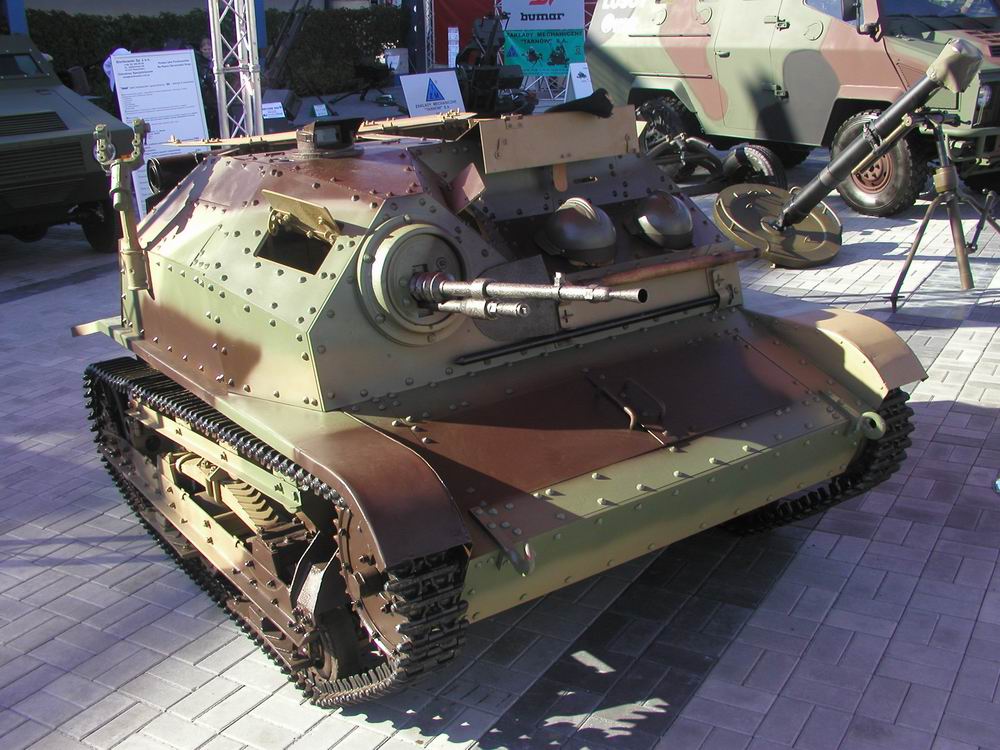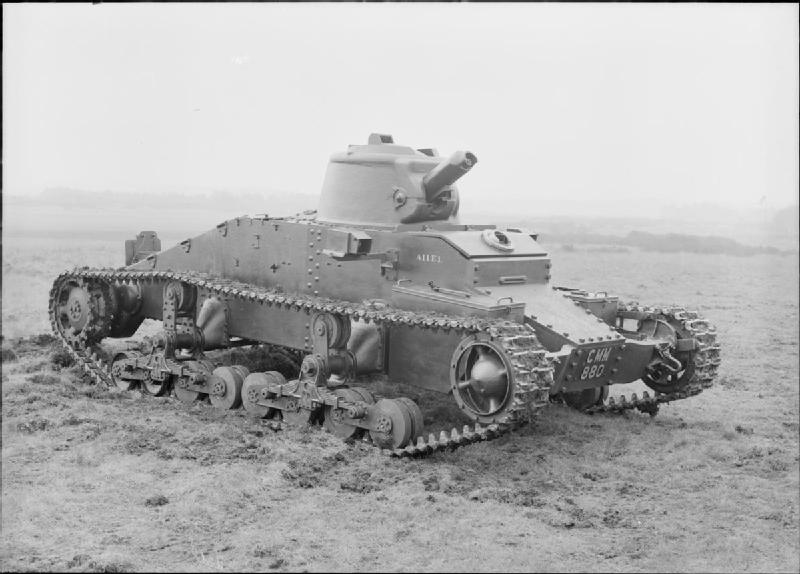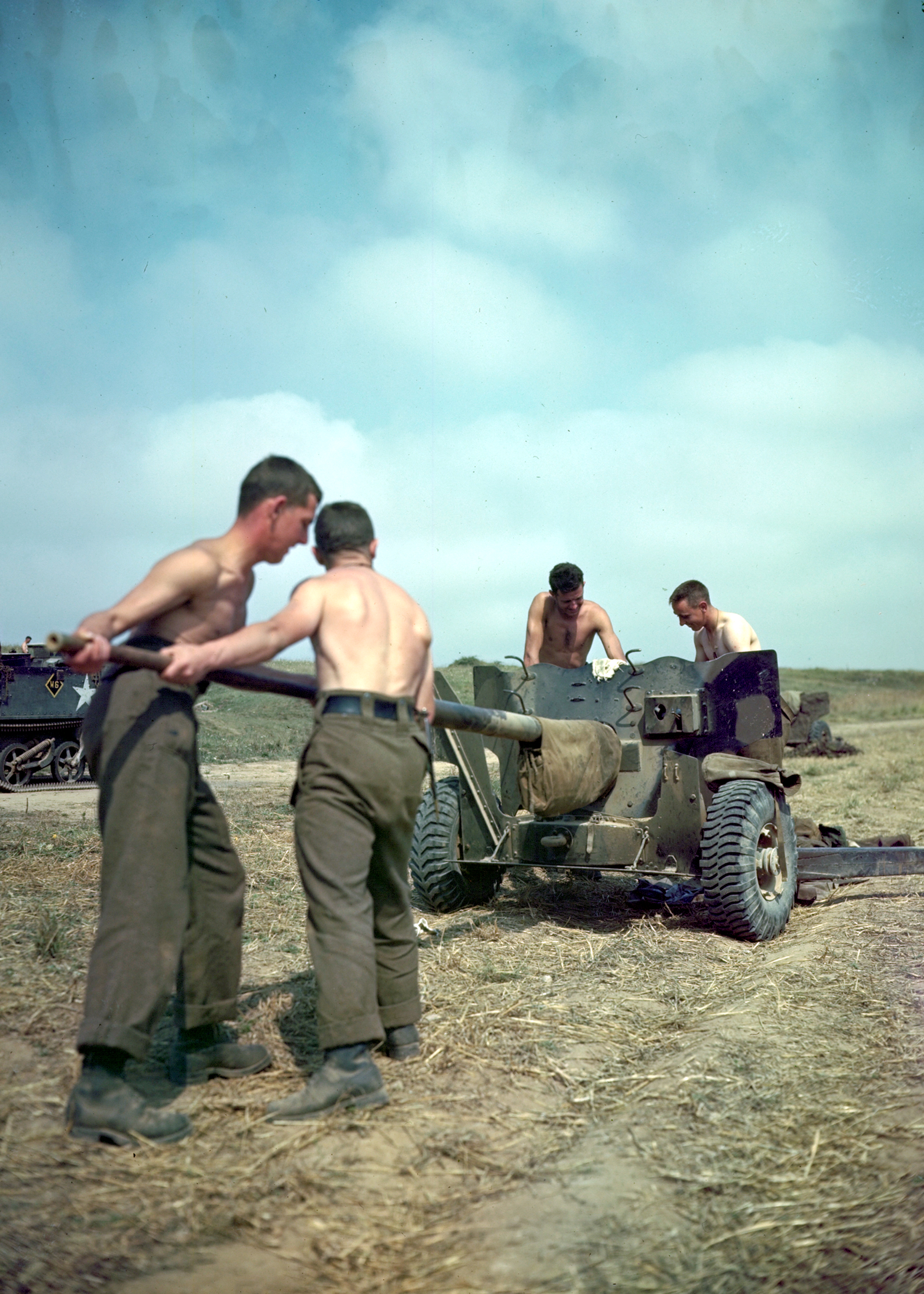|
British Armoured Fighting Vehicles Of World War II
Tanks of the Second World War Tankettes A tankette is a type of lightly armed and lightly armoured tracked combat vehicle resembling a small tank roughly the size of a car, mainly intended for light infantry support or reconnaissance. Colloquially it may also simply mean a "small tank". * Carden-Loyd tankette Medium tanks These inter-war tanks were built to supply the British Army after the First World War. Heavier than most light tanks, they proved to be under-gunned and under-armoured. Some did see action in France and the Low Countries in 1940. They were armed with either the QF 3 pdr or the Vickers machine gun. All were withdrawn from service by 1941. * Vickers Medium Mark I * Vickers Medium Mark II Light tanks These were a series of similar small tanks produced by Britain in the years between the First and Second World Wars mainly for use in Imperial duties. They saw use in training, and in limited engagements with British Imperial units in colonial policing actions ... [...More Info...] [...Related Items...] OR: [Wikipedia] [Google] [Baidu] |
Tankette
A tankette is a tracked armoured fighting vehicle that resembles a small tank, roughly the size of a car. It is mainly intended for light infantry support and scouting.T-27 Tankette (from the 'battlefield.ru' website, with further references cited. Accessed 2008-02-21.) Colloquially it may also simply mean a small tank. Several countries built tankettes between the 1920s and 1940s, and some saw limited combat in the early phases of World War II. The vulnerability of their light armour, however, eventually led armies to abandon the concept with some exceptions such as the more modern German Wiesel (Weasel) series. Characteristics Tan ...[...More Info...] [...Related Items...] OR: [Wikipedia] [Google] [Baidu] |
Infantry Tank
The infantry tank was a concept developed by the United Kingdom and France in the years leading up to World War II. Infantry tanks were designed to support infantrymen in an attack. To achieve this, the vehicles were generally heavily armoured to allow them to operate in close concert with infantry even under heavy fire. The extra armour came at the expense of speed, which was not an issue when supporting relatively slow-moving foot soldiers. Once an attack supported by infantry tanks had broken through heavily defended areas in the enemy lines, faster tanks such as cruiser or light tanks were expected to use their higher speed and longer range to operate far behind the front and cut lines of supply and communications. The infantry tank was superseded by the "Universal Tank" concept which could adequately perform the roles of both infantry and cruiser tank, as represented by the Centurion which replaced both the Churchill and any medium or cruiser tanks then in service. This le ... [...More Info...] [...Related Items...] OR: [Wikipedia] [Google] [Baidu] |
Ordnance QF 6 Pounder
The Ordnance Quick-Firing 6-pounder 7 cwt,British forces traditionally denoted smaller ordnance by the weight of its standard projectile, in this case approximately . The approximate weight of the gun barrel and breech, "7 cwt" (cwt = hundredweight), was included in the designation to distinguish this gun from others also firing a 6 lb projectile. or just 6-pounder, was a British 57 mm gun, serving during the Second World War as a primary anti-tank gun of both the British and United States Army (as the 57 mm Gun M1). It was also used as the main armament for a number of armoured fighting vehicles. Although designed before the start of the war, it did not reach service until the North African Campaign in April 1942. There, it replaced the 2-pounder as an anti-tank gun, allowing the 25-pounder gun-howitzer to revert to its intended artillery role. Development and production Development Limitations of the existing 2-pounders were apparent even as the gun entered ... [...More Info...] [...Related Items...] OR: [Wikipedia] [Google] [Baidu] |
Infantry
Infantry is a military specialization which engages in ground combat on foot. Infantry generally consists of light infantry, mountain infantry, motorized infantry & mechanized infantry, airborne infantry, air assault infantry, and marine infantry. Although disused in modern times, heavy infantry also commonly made up the bulk of many historic armies. Infantry, cavalry, and artillery have traditionally made up the core of the combat arms professions of various armies, with the infantry almost always comprising the largest portion of these forces. Etymology and terminology In English, use of the term ''infantry'' began about the 1570s, describing soldiers who march and fight on foot. The word derives from Middle French ''infanterie'', from older Italian (also Spanish) ''infanteria'' (foot soldiers too inexperienced for cavalry), from Latin '' īnfāns'' (without speech, newborn, foolish), from which English also gets ''infant''. The individual-soldier te ... [...More Info...] [...Related Items...] OR: [Wikipedia] [Google] [Baidu] |
Comet Tank
The Comet tank or Tank, Cruiser, Comet I (A34) was a British cruiser tank that first saw use near the end of the Second World War, during the Western Allied invasion of Germany. The Comet was developed from the earlier Cromwell tank and mounted the new 17 pdr High Velocity (HV) (3 inch; 76.2 mm – sometimes referred to as "77 mm") gun, in a lower profile, partly- cast turret. This gun was effective against late-war German tanks, including the Panther at medium range, and the Tiger. The Comet rendered the Cruiser Mk VIII Challenger obsolete, and led to the development of the Centurion tank. When firing APDS rounds, the 77 mm HV was superior in armour penetration capability to the 75 mm KwK 42 gun of the equivalent Axis tank, the Panther. The Comet entered active service in January 1945 and remained in British service until 1958. In some cases, Comets sold to other countries continued to operate into the 1980s. Design and developme ... [...More Info...] [...Related Items...] OR: [Wikipedia] [Google] [Baidu] |
Cruiser Mk VIII Challenger
The Tank, Cruiser, Challenger (A30) was a British tank of World War II. It mounted the QF 17-pounder anti-tank gun on a chassis derived from the Cromwell tank to add anti-tank firepower to the cruiser tank units. The design compromises made in fitting the large gun onto the Cromwell chassis resulted in a tank with a powerful weapon and reduced armour. The extemporised 17-pounder Sherman Firefly conversion of the US-supplied Sherman was easier to produce and, with delays in production, only 200 Challengers were built. The Challenger was able to keep up with the fast Cromwell tank and was used with them. History The driving force in the development of the Challenger was William Arthur Robotham. "Roy" Robotham had been a Rolls-Royce executive in the car division who, with no work to do, had led a team to develop a tank powerplant from the Rolls-Royce Merlin aircraft engine. The Rolls-Royce Meteor gave the British a powerful, reliable engine, which was used in the A27M Cru ... [...More Info...] [...Related Items...] OR: [Wikipedia] [Google] [Baidu] |
Cromwell Tank
The Cromwell tank, officially Tank, Cruiser, Mk VIII, Cromwell (A27M), was one of the series of cruiser tanks fielded by Britain in the Second World War. Named after the English Civil War-era military leader Oliver Cromwell, the Cromwell was the first tank put into service by the British to combine high speed from a powerful, reliable engine (the Rolls-Royce Meteor) and reasonable armour. The intended dual-purpose high velocity gun could not be fitted in the turret, so a medium velocity dual purpose gun was fitted instead. Further development of the Cromwell combined with a high velocity gun led to the Comet tank. The name "Cromwell" was initially applied to three vehicles during development. Early Cromwell development led to the creation of the A24 Cavalier. Later Cromwell development led to the creation of the competing Tank, Cruiser, Mk VIII, Centaur (A27L) design. The Centaur tank was closely related to the Cromwell, both vehicles being externally similar. The Cromwell ... [...More Info...] [...Related Items...] OR: [Wikipedia] [Google] [Baidu] |
Cavalier Tank
The Tank, Cruiser, Mk VII Cavalier (A24) was an interim design of British cruiser tank during the Second World War. It was derived from the A15 Crusader tank and was superseded by the A27 Cromwell tank. Development Early Development Development of the Cavalier initially started as development of the Cromwell tank. In mid-1940, the British were considering which tank should follow on from the new cruiser tanks then being developed. A specification was drawn up by the Directorate of Tanks and Transport which included the 57 mm QF 6 pounder gun. This led to General Staff specification A23 for a cruiser version of the A22 Churchill tank from Vauxhall, and A24 from Nuffield Mechanization & Aero Limited based upon their Crusader tank design. Birmingham Railway Carriage and Wagon Company (BRC&W) also submitted a design based on the Crusader. The Nuffield design used an uprated -- Liberty engine which was expected to give a top speed of . Armour would be from at th ... [...More Info...] [...Related Items...] OR: [Wikipedia] [Google] [Baidu] |
Crusader Tank
Crusader, in full "Tank, Cruiser Mk VI, Crusader", also known by its General Staff number A.15, was one of the primary British cruiser tanks during the early part of the Second World War. Over 5,000 tanks were manufactured and they made important contributions to the British victories during the North African campaign. The Crusader tank would not see active service beyond Africa, but the chassis of the tank was modified to create anti-aircraft, fire support, observation, communication, bulldozer and recovery vehicle variants. The first Crusader Mark I tanks entered service in 1941, and, though manoeuvrable, it was relatively lightly armoured and under-armed. The following Crusader Mark II had a maximum armour of . The main armament for the Crusader Mark I and II's was a 40 mm Ordnance QF 2-pounder gun; the following Crusader Mark III was fitted with a 57 mm Ordnance QF 6-pounder gun at the expense of one member of the crew in the turret. This variant was more th ... [...More Info...] [...Related Items...] OR: [Wikipedia] [Google] [Baidu] |
Covenanter Tank
The Cruiser tank Mk V or A13 Mk III Covenanter was a British cruiser tank of the Second World War. The Covenanter was the first cruiser tank design to be given a name. Designed by the London, Midland and Scottish Railway as a better-armoured replacement for the Cruiser Mark IV, it was ordered into production in 1939 before pilot models were built. Problems with the design became apparent only after production was under way. The tank equipped various British armoured divisions for home defence and training. It never left the UK as poor engine cooling caused the Mk I to Mk III to be declared unfit for overseas service especially in hot climates. This was rectified in the Mk IV after many corrective actions were undertaken but, by February 1944, it was declared obsolete. More than 1,700 of the type were built. It was named after the Covenanters, a Scottish religious faction at the time of the Wars of the Three Kingdoms. Development In 1938, the War Office had issued a require ... [...More Info...] [...Related Items...] OR: [Wikipedia] [Google] [Baidu] |
Cruiser Mk IV
} The Cruiser Tank Mk IV ( A13 Mk II) was a British cruiser tank of the Second World War. It followed directly on from the Tank, Cruiser, Mk III (A13 Mk I). The first Mk IVs were Mk IIIs with extra armour fitted to the turret. Later Mk IVAs were built with the complete extra armour. The tank was used in France in 1940 and in the early part of the war in North Africa, before being withdrawn from service. A fast vehicle compared to other British tanks of the early part of the war, it was probably the best tank Britain had in 1940. In total, 955 of these tanks were built. Design and development Britain became interested in fast tanks after observing the Soviet BT tanks during the 1936 Red Army manoeuvres. The BT was based on the revolutionary designs of American J. Walter Christie and a team from Morris Motors was sent to the United States to purchase a Christie tank and the rights to build more. The tank was given the General Staff designation "A13E1" and was delivered in late ... [...More Info...] [...Related Items...] OR: [Wikipedia] [Google] [Baidu] |
Cruiser Mk III
The Tank, Cruiser, Mk III, also known by its General Staff specification number A13 Mark I, was a British cruiser tank of the Second World War. It was the first British cruiser tank to use the Christie suspension system, which gave higher speeds and better cross-country performance; previous cruiser tank models had used triple wheeled bogie suspension. Design and development British cruiser tank design began with the Mk I and somewhat heavier Mk II in the mid-1930s. Just as prototypes were arriving in 1936, General Giffard LeQuesne Martel, a pioneer in tank design who had published works on armoured warfare and pioneered the lightly armoured "tankette" to enhance infantry mobility, became Assistant Director of Mechanization at the War Office.Milsom Later that year, Martel witnessed demonstrations of Soviet tank designs, including the BT tank, which had been influenced by American J. Walter Christie's work. Martel urged the adoption of the Christie suspension and Christie's ... [...More Info...] [...Related Items...] OR: [Wikipedia] [Google] [Baidu] |








_front-left_2017_Bovington.jpg)

